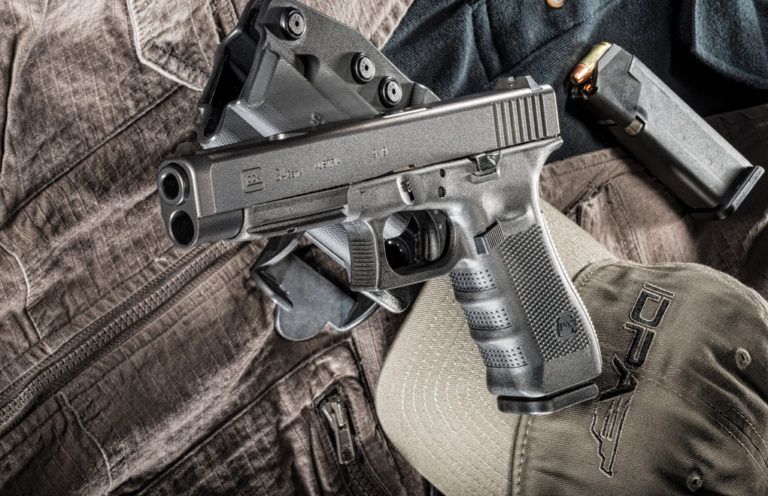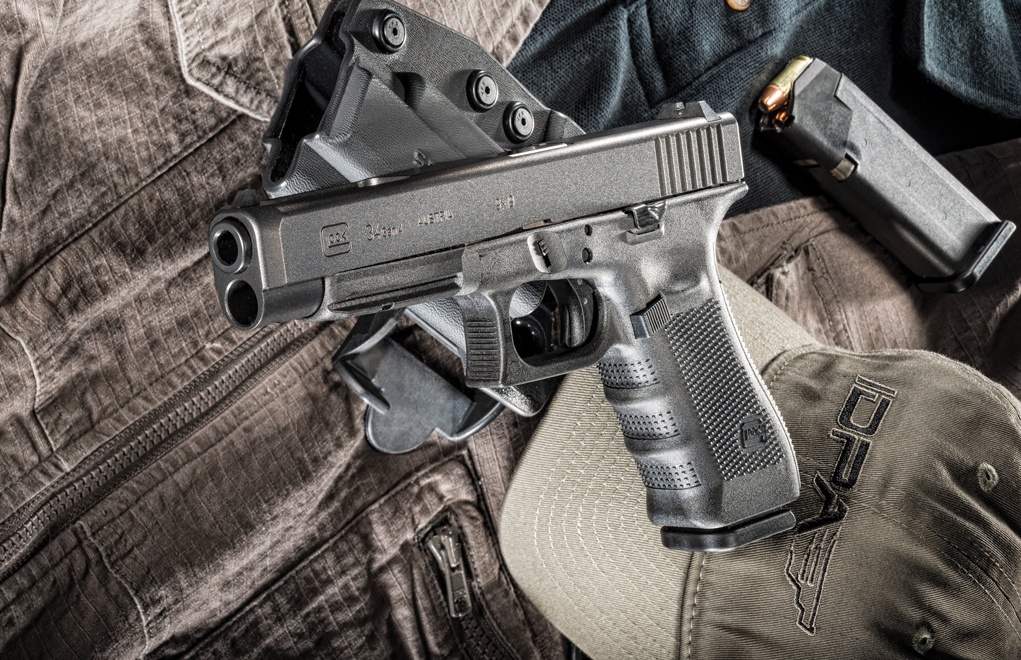
Love 'em or hate 'em, the Glock train continues to roll.
What are the top Glocks:
During the past 30 years, the name “Glock” has come to symbolize quality and reliability. But that wasn’t the case when it was first introduced to the American market in the mid ‘80s. American gun owners were more than skeptical about the “plastic gun.” Some were dismissive, and others were just downright mean.

In return, Glock came up with a great idea to change the minds of American gun owners: put the pistols in their hands and allow the shooters to not only handle them, but to shoot them. This led to the creation of the Glock Range Program.
Until 1990, I’d only seen Glocks on the gun store shelves. But one day, our small local range had all these brand-new Glock pistols, in all models and calibers (9mm and .40 S&W at that time). There they were, ready to be rented at a reasonable price, and that was it for me — I was hooked. I had never seen rental pistols at any of the ranges I’d been to, and this quickly became a great concept that allowed members to test drive Glocks and pick the model and caliber that best fit their likes and needs.
Glock Reviews You Need To Read
After a couple of years, the American market embraced the plastic gun, and Glock has become an important part of the landscape for law enforcement and recreational shooters alike.
Building Momentum
The first Glock to hit our shores was the Model 17, in what has been named the first generation, which was a 17-round pistol with a pebble texture grip and very simple controls. In 1988, the Gen 2 pistols were introduced, with changes like a checkered front strap and serrated back strap. During the lifetime of the Gen 2 run, some simple changes were also introduced, such as a captured one-piece guide rod system and minor changes in the magazine floor plate.
In 1998, we saw the introduction of the Gen 3 models. These guns featured upgrades like an accessory rail (called the Universal Glock rail) to allow the mounting of laser sights, tactical lights and other accessories. Thumb rests on both sides of the frame and finger grooves on the front strap also appeared.
During the middle of the Gen 3 lifetime, several more changes were made to the Glock line, including a modified extractor that serves as a loaded chamber indicator, an enlarged locking block and an extra cross pin (to aid the distribution of bolt thrust forces exerted by the locking block) located above the trigger pin. The Gen 3 frames were offered in black, flat dark earth and olive drab. Other models, like a non-firing dummy pistol (“P” models), non-firing dummy pistols with resetting triggers (“R” models) with a bright red frame, and simunition practice pistols (“T” models) with a bright blue frame, were also released.
Then, at the end of the G3 lifespan, the RTF2 (Rough Textured Frame 2) was introduced. These variations featured a new checkering texture around the grip and new scalloped serrations at the rear of the slide.
In early 2010, Gen 4 Glocks were introduced. The Gen 4 modifications were mostly ergonomic, such as a modified rough-textured frame and grip checkering. A new recoil spring assembly was also introduced, along with an enlarged reversible ambidextrous magazine release. Magazines were modified to accept the ambidextrous magazine release, and accessory interchangeable backstraps of different sizes and shapes were released.
The basic grip size and shape of the Gen 4 Glock pistols is slightly smaller compared to previous generations, and some parts on the Gen 4 models can’t be interchanged with previous models. During the early introduction of those Gen 4 pistols, Glock announced a recoil system exchange program, where owners were sent a new modified recoil system in exchange for the recoil system originally shipped with the pistols.
In 2016, the FBI issued a solicitation to Glock for 9mm duty pistols, which deviated from the Gen 4 pistols and led Glock to develop the M Series pistols. In turn, the M Series pistols led to development of the Gen 5 pistols in 2017.
Modifications to the Gen 5 Glocks were centered on improving reliability and ergonomics, and changes included an ambidextrous slide stop, revised style of polygonal rifling that Glock named “Glock Marksman Barrel,” deeper recessed barrel crown, the removal of finger grooves from the frame, flared magazine well, the reintroduction of the half-moon cutout in the bottom of the front strap, beveled and rounded front of the slide, and removal of the extra locking block pin introduced on the Gen 3 pistols.
The magazines on the Gen 5 pistols feature slight differences from their predecessors, with a slightly redesigned baseplate for easy removal and an orange follower for easy identification.
Glock Talk: Discover More Tips & Reviews
- Why is the Glock 19 Popular
- Glock Upgrades – Customizing for Performance
- Glock 19 Review: Glock 9mm Double Stack
- Test Driving the Glock 43 Single-Stack
- Glock 26 for Concealed Carry – The Best Double-Stack 9mm?
- Glock 34 for Concealed Carry – What Makes The Glock 34 A Top Competitor?
- What is the Best Glock for Concealed Carry?
- CCW Glock 30S – Is the G30S Good for Concealed Carry
- 10mm Glock Models – What Are The Best Options?
- Glock 43X vs Glock 48
Glock 34

Originally advertised as “practical and tactical,” the Glock 34 and 35 were designed specifically for the International Practical Pistol Confederation (ISPC) market and in accordance to IPSC rules. Released in 1998, the Glock 34 was an instant hit with Practical Pistol Shooters all over the world.
Ironically, when production division was started in 2000, the Glock 34 and 35 were excluded because of their 5.25-inch barrels; IPSC had set a limit of 5 inches for barrel length. But that didn’t stop the United States Practical Shooting Association (USPSA) and the International Defensive Shooting Association (IDPA) to allow the Glock 34 to compete in their Production (USPSA), SSP (IDPA) and ESP (IDPA) Divisions.
Today, the Glock 34 is the most popular Glock pistol in those divisions. I’ve owned several versions of the Glock 34 and have used it for USPSA and IDPA alike, and I can’t wait for the release of the Glock 34 Gen 5. Glock, are you listening?
Glock 22

After the release of the .40 S&W cartridge, specifically designed for the law enforcement market, it didn’t take long for Glock to manufacture a pistol for this exciting new cartridge — and they hit a home run. The Glock 22 quickly became the most adopted handgun in the American law enforcement community, with countless departments switching to both the .40 S&W cartridge and the Glock 22 as their main service pistol.
For more than a decade, it seems like every department — federal, state, county and city departments — was carrying a Glock 22. Now, with the improvements in 9mm ballistics and bullet design during the past 2–3 years, many departments are switching back to the 9mm cartridge due to its higher capacity and lower recoil, and many officers are welcoming back the easier-to-shoot 9mm cartridge.
Glock 26

Released in 1994, the Glock 26 is often referred to as the “Baby Glock” and was nothing more than a chopped down version of the classic Glock 17. Using the same basic configuration as the Glock 17, its grip was reduced to hold only 10 rounds and its slide reduced to accept its 3.42-inch barrel.
With the growing number of states allowing civilians to carry handguns concealed, the Glock 26 became the first choice for many concealed carry participants, and it also served as backup for both the civilian market and law enforcement personnel alike. Today, with a plethora of smaller and slimmer handguns in the market, the Glock 26 has lost some of its market, but is still a great choice for backup and CCW.
Glock Glock 17

The one that started it all, the Glock 17, has become the flagship for the Glock family of handguns, now in its 5th generation. The Glock 17 has just about every market cornered. From law enforcement to recreational shooters, self-defense, military and competitive shooters, the medium-sized Glock 17 is the classic against which other striker-fired pistols are measured.
With a capacity of 17 rounds and a 4.48-inch barrel, the Glock 17 remains one of the most-used pistols in the world. I prefer the Glock 17 for competition over the more popular Glock 34; the grip is exactly the same as the longer-barreled Glock 34, but I find the shorter barrel and slide easier to transition from target to target, making it my No. 1 choice for both USPSA and IDPA matches.
Glock 19

Released in 1998, at the same time as the Gen 2 pistols, the Glock 19 has become a classic. With more compact dimensions compared to the larger Glock 17, the Glock 19 was designed around a 15-round magazine and a more compact 4.01-inch barrel, making it just about the perfect size for concealed carry while affording the shooter a good capacity of ammunition.
I’ve carried a Glock 19 on and off for the past 15 years, and to this day I find it one of the most comfortable pistols for everyday carry. And with the numbers of Glock 19s sold, I guess I’m not the only one who considers the Glock 19 to be the best Glock for self-defense.
The Final Round
As a longtime Glock user, I’ve owned and fired every one of the pistols on this list. I’ve liked them all, but I can’t pick one of these models over the others — they all have a purpose and they all work great. I will continue to use my Glock 17 for competition and recreational shooting, and my Glock 19 Gen 2 for everyday carry. I guess more than 30 years of experience has made Glock my choice for recreation, competition and self-defense.
Editor's Note: This article originally appeared in the May 2018 issue of Gun Digest the Magazine.
Learn More About Glock Options
- Glock 44 Review
- Glock 19 Review
- Glock 43 Review
- Glock 17 Review
- Glock 26 Review
- Glock 42 Review
- Glock 34 Review
- Glock 22 Review
- Glock 40 Review
- Glock 20 Review
- Glock 30 Review
- Glock 41 Review
- Glock 29 Review
- Glock 43X Review

Next Step: Get your FREE Printable Target Pack
Enhance your shooting precision with our 62 MOA Targets, perfect for rifles and handguns. Crafted in collaboration with Storm Tactical for accuracy and versatility.
Subscribe to the Gun Digest email newsletter and get your downloadable target pack sent straight to your inbox. Stay updated with the latest firearms info in the industry.

![Best Concealed Carry Guns In 2025 [Field Tested] Wilson Combat EDC X9S 1](https://gundigest.com/wp-content/uploads/Wilson-Combat-EDC-X9S-1-324x160.jpg)


![Best 9mm Carbine: Affordable PCCs [Tested] Ruger Carbine Shooting](https://gundigest.com/wp-content/uploads/Ruger-Carbine-Shooting-100x70.jpg)
![Best AR-15: Top Options Available Today [Field Tested] Harrington and Richardson PSA XM177E2 feature](https://gundigest.com/wp-content/uploads/Harrington-and-Richardson-PSA-XM177E2-feature-100x70.jpg)
